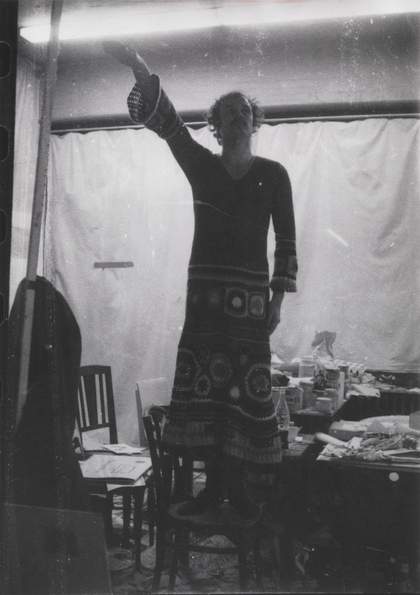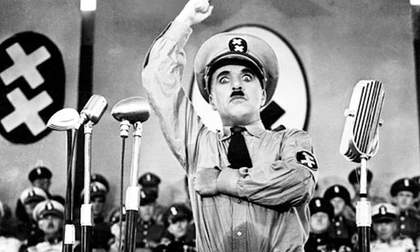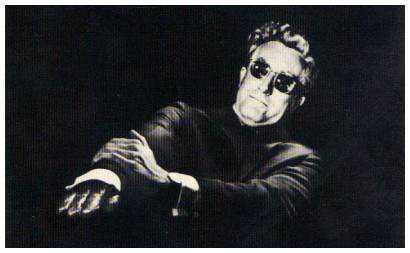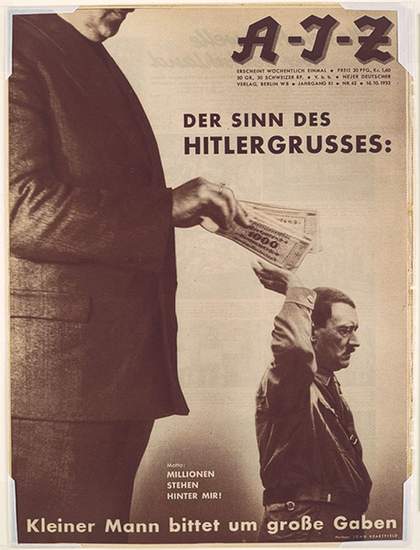I wanted to find out for myself if art is at all possible after fascism. I wanted to see behind the phenomenon of fascism’s appearance, behind its surface, what the abyss of fascism means for myself, because this history is part of reality, it’s also part of my self-discovery … I wanted to depict the unimaginable in myself.
Anselm Kiefer (2008)1
Given the multiple possibilities of the meaning of the word ‘occupations’ in the original German (Besetzungen) – which can refer to territorial expansionism, student sit-ins, cathexis (a psychoanalytic term for ‘holding fast’), the transferral of meaning onto a symbol or the casting of a play (or the assumption of a role within it) – there is an ambivalence about the psychological motivations of the performer in Anselm Kiefer’s Occupations action and the Heroic Symbols photographs that document them (Tate AR01162; fig.1).2 But semantic ambivalence is at the core of his work, something that Kiefer, who is as much a visual poet as visual artist, has acknowledged and welcomed.3 A key issue concerns the position of the artist in trying to understand what constitutes a National Socialist, as he momentarily and atavistically ‘occupies’ the body, pose and psyche of a Nazi in order to later step back and analyse the make-up of the symbolic father, and more broadly, to examine what happened to the age-old notion of the ‘fatherland’. As Kiefer stated in an oft-cited remark: ‘I do not identify with Nero or Hitler, but I have to reenact what they did just a little bit in order to understand the madness. That is why I make these attempts to become a fascist’.4 However, this poses a further difficult question: if one re-enacts a gesture, particularly as many times as Kiefer did (in an inassimilable compulsion to repeat), can one avoid the process of ‘identification’? Andrea Lauterwein has considered the impetus for Kiefer’s performance:
In order to gauge the effect on the conqueror’s psyche of occupying a town, Kiefer therefore carried out a ‘conceptual identification’; he acted out a means of being in a world that he had never known himself, using his own body, combining it with sets and costumes, and submitting himself to the ‘inner quest’ which he had discovered in Konstantin Stanislavsky’s An Actor’s Handbook.5

Fig.1
Anselm Kiefer
Heroic Symbols (Heroische Sinnbilder) 1969
Photograph, black and white, on paper
Tate and National Galleries of Scotland, Edinburgh
© Anselm Kiefer
Reading the National Socialist art magazines that his father kept in the attic, which Kiefer would later cut up and use in his 1969 artist books Heroic Symbols and For Jean Genet, was one method of preparing himself for this ‘conceptual identification’, but before he performed the role of a saluting National Socialist Kiefer would listen to recordings of public speeches made by Hitler, Hermann Goering and Josef Goebbels. In this respect, there is a parallel with German artist Joseph Beuys’s most controversial Fluxus action at the Festival of New Art in Aachen in 1964 when as part of his performance he repeatedly played a recording of Goebbels’s Sportpalast speech delivered in Berlin in 1943, which led to a highly fractious atmosphere resulting in a brawl that left Beuys with a bloody nose. The recordings that Kiefer listened to, made by Americans to educate Germans about their own history, enabled him to embody the role of a National Socialist, effectively actuating his performance and existentially gaining some sense of what it meant to be a German during that historical moment. It is worth remembering that Kiefer was born in March 1945, exactly two months before VE day. He has spoken of the need he felt as a young man in 1969 to somehow retrieve and concretise that recent history from a German curriculum that had made these turbulent years feel distant and abstract, and deliberately so. Since then his work has attempted to address this problem, ever conscious of what Jorge Semprún observed in 2005 at the sixtieth anniversary of the liberation of Buchenwald, when he said ‘the cycle of active memory is closing’.6 In 2011, reflecting back on his position in 1969, Kiefer stated:
It had all only happened just a couple of decades earlier, but in school it was taught as if it was about Alexander the Great. It was a dry piece of ancient history. And although my father had been an officer during the war, the war was not really talked about at home. My father was not a Nazi, but of course he was infiltrated by the ideology. So my family, like many others, stuck to this illusion about the Wehrmacht not being Nazis, just being soldiers. But of course we know today a lot of them were involved in the extermination of Jews and others.7
While Kiefer’s preparations for his self-representation as a National Socialist through listening to recordings of rally speeches might have followed the Stanislavskian method in his attempt to embody a past experience by ‘occupying’ the emotions of the symbolic ‘father’, it is arguable that he did not completely lose himself in the role, but rather, in a Brechtian sense, maintained a critical attitude towards it. This detachment arose from the ways Kiefer divorced the Sieg Heil gesture from the conventions and contexts through which it had typically been mediated in the post-1945 period, namely through historical photographs, archival newsreel reports and war films. In Kiefer’s photographs taken ‘on location’ the ceremonial manifestations of Nazi power that became familiar through the films of Leni Riefenstahl and others – massed troops on the parade ground, torches, flags and worshipping crowds – are all absent, and such spectacle is replaced by a lone and absurd-looking figure often seen from a distance. Kiefer’s unusual outfits, his frequently dishevelled appearance and unmilitary posture, the non-German exterior and the incongruous interior settings all form part of a process of defamiliarisation prompting the spectator, especially the German spectator, to reflect more closely on the nature of the gesture and Nazism more generally.
Of Occupations and Heroic Symbols it is often stated that Kiefer posed as a National Socialist Party member, but if one considers his 1975 photo-essay ‘Occupations’ (published in the art magazine Interfunktionen) alongside the books Heroic Symbols and For Jean Genet in which he incorporated many of the Heroic Symbols photographs, it seems more complex than this. Kiefer often played roles within the role; the figure of the archetypal Nazi was not at all stable in this respect and was subverted by the artist in a number of ways. In For Jean Genet he appears as a cross-dresser in a white nightshirt or embroidered dress, which alludes to the French writer Jean Genet’s complex sexuality, and as the art historian Lisa Saltzman has argued, this breaks down any ‘presumed binarism’ between homosexuality and fascism by revealing the ‘repressed subtext of the “fascist unconscious”’.8 In Genet’s novel Funeral Rites (1947), for instance, a work that depicts murder, rape, torture, sodomy, cannibalism and mutilation, among other extreme acts of degradation, the first-person narrator has a wartime fantasy that his dead lover’s half-brother becomes Hitler’s lover and ends up sodomising the Führer.

Fig.2
Charlie Chaplin as Hitler in The Great Dictator (1940) (film still)
The historian of German culture Peter Arnds has suggested that Kiefer’s Occupations performance places him in a tradition of carnivalising the Sieg Heil salute in German visual and literary culture, and he rightly points to other examples such as Volker Schlöndorff’s 1978 film adaptation of Günter Grass’s 1959 novel The Tin Drum and Albert Bloch’s painting March of the Clowns 1941 (Jewish Museum, New York).9 Arnds also mentions non-German examples such as Mel Brooks’s film The Producers (1968) with its musical number ‘Springtime for Hitler’, and wartime films such as Charlie Chaplin’s The Great Dictator (1940; fig.2), Ernst Lubitsch’s To Be or Not to Be (1942), as well as later films where the gesture is parodied such as Agnieszska Holland’s Europa Europa (1991) and Roberto Benigni’s Life is Beautiful (1998). Arnds has argued that wartime parodies of the Hitler salute as seen in, for example, Chaplin’s The Great Dictator, in ‘their relative ignorance of the full range of Nazi crimes are somewhat naïve’.10 Kiefer has expressed a similar sentiment, stating that ‘Chaplin regretted it in the end. He said “He is not a clown … he is a terrible man”’.11 Kiefer’s position also echoes the thoughts of Theodor Adorno who believed the true horror of fascism was too easily trivialised and conjured away by the ‘buffoonery’ evident in The Great Dictator.12
To Arnds’s list of films that carnivalise the salute, one could also add the 1943 Der Fuehrer’s Face (originally titled Donald Duck in Nutzi Land) by Walt Disney Productions, Russian Rhapsody (1944) from Warner Brothers’s Merrie Melodies theatrical cartoon series and the British propaganda montage film Hoch der Lambeth Walk (1941), which showed Hitler shouting and saluting while his soldiers troop danced to the music of the Lambeth Walk. The images, reversed and repeated for comic effect, were taken from Riefenstahl’s Triumph of the Will (1935).

Fig.3
Peter Sellers in Stanley Kubrick’s Dr Strangelove or: How I Learned to Stop Worrying and Love the Bomb (1964)
(film still)
Later came Stanley Kubrick’s satire Dr Strangelove or: How I Learned to Stop Worrying and Love the Bomb (1964), which features Peter Sellers in multiple roles, including Dr Strangelove, an invalided ex-Nazi scientist who twice addresses the American President as ‘Mein Führer’ and is unable to suppress the desire to make the Nazi salute when becoming excited over the thought of nuclear Armageddon and the creation of a new world order (fig.3). In addition to these films was the dadaist John Heartfield, an artist who surprisingly Arnds does not include in his thought-provoking essay, but who successfully carnivalised the image of Hitler, making him appear extremely foolish and corrupt through the technique of photomontage. 13 In one of his most potent photomontages of Hitler, Der Sinn der Hitlergrusses (in English The Meaning of the Hitler Salute) of 1932 (fig.4), Heartfield suggests the salute is a plea for money by juxtaposing Hitler’s saluting arm with a fat wealthy Rhineland industrialist, who passes the Führer thousands of Deutschmarks. Like Heartfield, Kiefer also used photography, but through self-representation chose performative masquerade rather than montage as his iconoclastic weapon of choice – that is, masquerade as a means of actually unmasking the ‘heroic symbol’. Since Heartfield and Kiefer, other German artists have created artworks referring to or mocking the Hitler salute. In 2009 Ottmar Hörl displayed 1,250 black and gold garden gnomes with their arms outstretched in a Hitler salute in the central marketplace of a southeastern German town called Straubing, on a square that used to be a site of Nazi parades. This satirical work alludes to the lingering presence of Nazism in German society. Furthermore, the performance artist Jonathan Meese also courted controversy in 2013 by performing the Nazi salute on two occasions, but avoided punishment in a Kassel court.

Fig.4
John Heartfield
The Meaning of the Hitler Salute (Der Sinn des Hitlergrusses) 1932
Metropolitan Museum of Art, New York
Kiefer’s work cannot be fully explained by reference to parody alone, and the fact that it cannot may be what makes the viewer somewhat uneasy. Kiefer’s comment on Chaplin suggests that he did not believe that fascism was rendered innocuous when subjected to ridicule. While his action may have deflated the pomposity of the Sieg Heil, showing it to be absurd and pathetic, Kiefer still sought answers to some very difficult questions, as he articulated in a 1987 interview: ‘Am I a fascist? It’s very important, and one cannot give a swift answer. The authority, the spirit of competition, the feeling of superiority … these are aspects of me just as they are of each and every one of us. One must choose the right path. To say that I am one thing or another is too simple. I wanted to depict the experience before the response’.14 The historian Simon Schama understood this aspect of Occupations when he wrote that it is ‘half parody, half sermon. If this was clowning around by a sixties dropout law student, the corners of the clown’s mouth were turned down’.15
